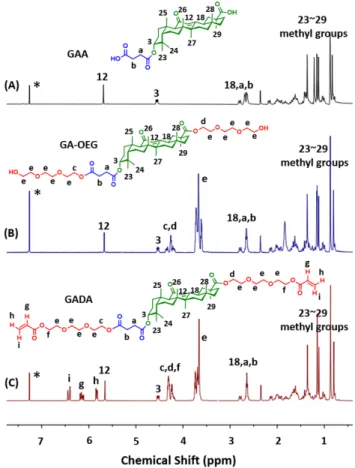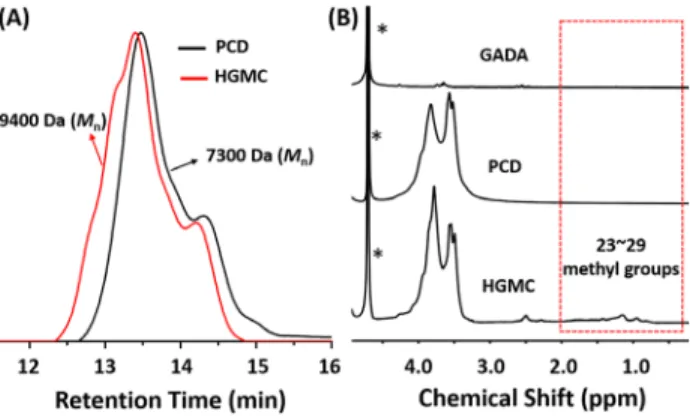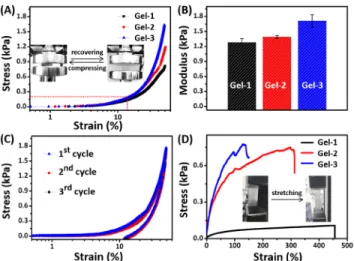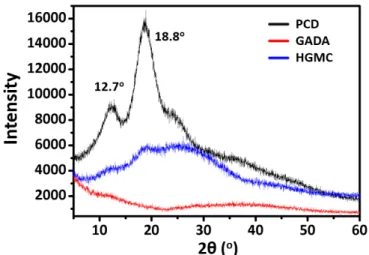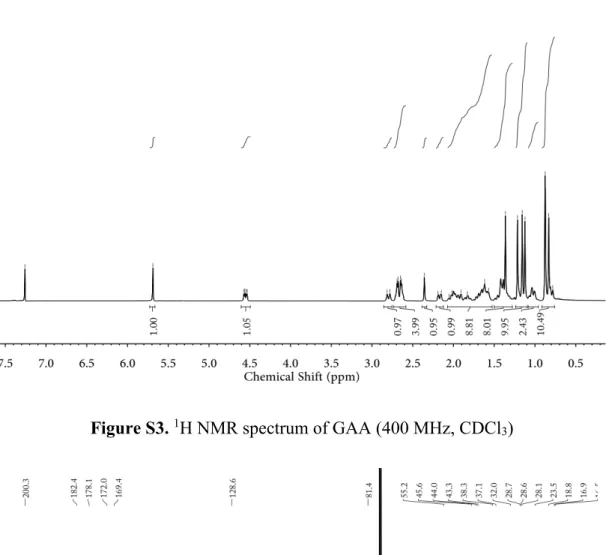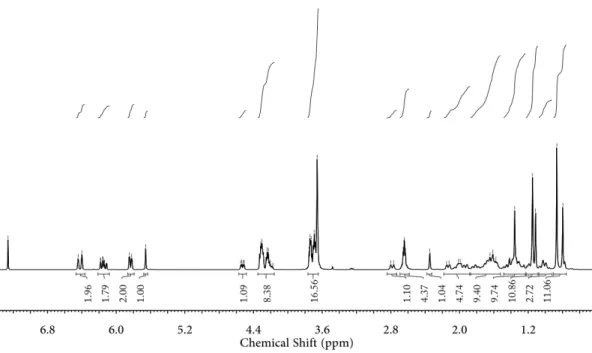HAL Id: hal-03051825
https://hal.archives-ouvertes.fr/hal-03051825
Submitted on 22 Dec 2020
HAL is a multi-disciplinary open access
archive for the deposit and dissemination of
sci-entific research documents, whether they are
pub-lished or not. The documents may come from
teaching and research institutions in France or
abroad, or from public or private research centers.
L’archive ouverte pluridisciplinaire HAL, est
destinée au dépôt et à la diffusion de documents
scientifiques de niveau recherche, publiés ou non,
émanant des établissements d’enseignement et de
recherche français ou étrangers, des laboratoires
publics ou privés.
Tough Polymeric Hydrogels Formed by Natural
Glycyrrhetinic Acid-Tailored Host–Guest
Macro-Cross-Linking toward Biocompatible Materials
Ge Xu, Jiawei Li, Jianqiao Wu, Hao Zhang, Jun Hu, Min-Hui Li
To cite this version:
Ge Xu, Jiawei Li, Jianqiao Wu, Hao Zhang, Jun Hu, et al.. Tough Polymeric Hydrogels Formed
by Natural Glycyrrhetinic Acid-Tailored Host–Guest Macro-Cross-Linking toward Biocompatible
Ma-terials. ACS Applied Polymer Materials, American Chemical Society, 2019, 1 (10), pp.2577-2581.
�10.1021/acsapm.9b00723�. �hal-03051825�
Tough Polymeric Hydrogels Formed by Natural Glycyrrhetinic
Acid-Tailored Host-Guest Macro-Crosslinking Toward Biocompatible
Ma-terials
Ge Xu,
†Jiawei Li,
†Jianqiao Wu,
†Hao Zhang,
†Jun Hu*
,†and Min-Hui Li*
,†,‡†Beijing Advanced Innovation Center for Soft Matter Science and Engineering, Beijing University of Chemical Tech-nology, Beijing 100029, China
‡Chimie ParisTech, PSL University Paris, CNRS, Institut de Recherche de Chimie, Paris 75005, France
KEYWORDS: polymeric hydrogel, host–guest pairs, cyclodextrins, glycyrrhetinic acid, natural product
ABSTRACT: Host-guest polymeric hydrogels often suffer from poor biocompatibility and weak mechanical strength owing to the low complexation degree between host- and guest-polymers. In contract to reported works, here a biocompatible host-guest macro-crosslinker (HGMC) was synthesized beforehand by complexation of poly(β-cyclodextrin) with natural glycyrrhetinic acid-derivative functionalized with acrylates at two extremities. After crosslinking polyacrylamide three pol-ymeric hydrogels were obtained, the swelling ratios and micro-pore sizes of which could be adjusted effectively by HGMC content. Moreover, they exhibited robust anti-compressing and elastic features. These biocompatible tough polymeric hy-drogels hold the promise for potential applications as biomaterials.
Host-guest polymeric hydrogels, consisting of 3D networks crosslinked by host-guest interactions, have attracted con-siderable attention by virtue of their distinct stimuli re-sponsiveness and inherent processability.[1-3] Currently, one of the most common strategies is to prepare host-pol-ymers and guest-polhost-pol-ymers by grafting host and guest func-tional groups on polymer main chains, respectively.[4-6] Un-fortunately, low grafting degrees are often obtained be-cause of the steric hindrance of polymer backbones, thus leading to the weak mechanical strength. In addition, these hydrogels also suffer from poor biocompatibility as non-renewable host-guest pairs are frequently used, which fur-ther restricts their applications in biocompatible materi-als.[7-9] Thus, it is of great importance to develop a simple yet useful method for constructing host-guest polymeric hydrogels with high mechanical strength from biocompat-ible host-guest pairs.
Cyclodextrins (CDs), cyclic oligomers of D-(+)-glu-cose linked via α-1,4-gluD-(+)-glu-cose bond, are produced from en-zymatic processing of starch with good biocompatibility and availability.[10] More importantly, the hydrophobic cav-ity of CDs makes them typical host molecules to bind with various guest molecules like adamantane,[11,12] azoben-zene,[13,14] ferrocene,[15,16] cholic acid,[17,18] and glycyrrhetinic acid,[19,20] according to the size and hydrophobicity. As firstly reported by us in 2016, natural glycyrrhetinic acid (GA) has a mild binding affinity with β-cyclodextrin (β-CD) (Ka = 1.59 × 103 M-1) and great biocompatibility.[19] GA is a 30 C-containing plant metabolite in licorice root and pos-sesses a variety of remarkable biocompatibility and biolog-ical activities.[21] The fused pentacyclic structure offers GA
a rigid molecular backbone of nanometric dimensions. Be-sides, the presence of hydroxyl and carboxyl groups with several chiral centers makes GA an interesting building block for chiral assemblies and materials.[22-24] In our pre-vious works, we found that the GA/β-CD pair adjusted the LCST (lower critical solution temperature) behavior of co-polymers composed of GA-based methacrylate and N,N’-dimethylacrylamides,[25] dictated the construction of polypseudorotaxanes of GA-tailored polyurethane,[20] and drove the formation of self-healable supramolecular hy-drogels by grafting GA and β-CD to N,N’-dimethylacryla-mide copolymers.[19] Obviously, GA/β-CD is an ideal bio-compatible host-guest pair for constructing the host-guest polymeric hydrogels.
In order to circumvent the weak mechanical strength of GA/β-CD hydrogels caused by the low grafting degree of GA and β-CD on polymer backbones, in this research we reported a simple strategy for preparing tough host-guest polymeric hydrogels by using a macro-crosslinker. In this strategy, the GA-derivative with two terminal acrylates (GADA) and poly(β-cyclodextrin) (PCD) were used as bio-compatible guest and host to fabricate the host-guest maccrosslinker (HGMC) beforehand. After that, the ro-taxane-type hydrogels were produced by crosslinking acrylamide (AAm) in the presence of HGMC via a UV photo-polymerization (Scheme 1). There were several ad-vantages in this strategy: 1) the host-guest complexation was formed before the polymerization, which avoided the issues of steric hindrance of polymer backbones; 2) besides the crosslinking between GADA and polyacrylamide, the inclusion between PCD and GADA provided additional crosslinking sites, which endowed the hydrogels better
mechanical performance; 3) when external forces were ap-plied to the hydrogels, the host-guest interactions between PCD and GADA in these rotaxane-type hydrogels could dissipate energy by sliding β-CD from GA backbone, con-sequently making the hydrogels very tough. The results showed that all the hydrogels with different molar ratios of HGMC and AAm were anti-compressing, nonfragile and elastic. Moreover, they could easily recover to their original states on account of the host-guest interactions. This work provided an effective way to construct biocompatible pol-ymeric hydrogels with good mechanical strength for po-tential applications as biomaterials in soft-tissue repair. Scheme 1. Schematic illustration of (A) glycyrrhetinic acid-derivative functionalized with acrylates at two extremities (GADA), (B) poly(β-cyclodextrin) (PCD), and (C) polymeric hydrogels formed by host-guest macro-crosslinking.
For the preparation of host–guest macro-crosslinker HGMC, GADA and PCD were firstly synthesized as shown in Scheme 1A and 1B. GA reacted with succinic anhydride to give the intermediate (GAA) with proton signals at 2.65 and 2.69 ppm assigning to methylene groups (Ha, Hb, Fig-ure 1A). 2-[2-(2-chloroethoxy)ethoxy]ethanol was then conjugated to GAA via an ester reaction, affording another intermediate (GA-OEG) with peaks at 3.60~3.73 and 4.18~4.37 ppm belonging to methylene groups of OEG moi-ety (Hc, Hd, He, Figure 1B). Lastly, the guest molecule GADA was obtained by reacting GA-OEG with acryloyl chloride, and the classic proton signals from terminal acry-lates at 5.85, 6.15 and 6.40 ppm (Hg, Hh, Hi) were observed clearly (Figure 1C), strongly indicating the successful syn-thesis of GADA. On the other hand, PCD was synthesized through copolymerizing epichlorohydrin with β-CD. As can be seen from 13C NMR spectrum (Figure S1), the peaks
at 62 and 72 ppm were assigned to the characteristic meth-ylene carbon formed in the polycondensation of epichloro-hydrin with β-CD.[26,27] Besides, the size exclusion chroma-tography (SEC) showed that PCD had a molecular weight (Mn) 7300 Da (calibrated with polystyrene standard, Figure 2A).
Figure 1. 1H NMR spectra of (A) GAA, (B) GA-OEG and (C)
GADA (400 MHz, CDCl3). *represents the solvent peak.
Subsequently, the macro-crosslinker HGMC was pre-pared by mixing the oil-like GADA into an aqueous solu-tion of PCD. As shown in Scheme 1C, after stirring for 24 h, the light yellow oil of GADA floating on the up-layer of PCD aqueous solution disappeared and a homogeneous dispersed solution was generated, because the hydropho-bic interior cavity of PCD had trapped GADA. To clarify the host-guest interactions between GADA and PCD, 1H NMR, SEC and X-ray diffraction (XRD) measurements were performed. No signal of methyl groups on GA moiety was observable in 1H NMR spectrum of GADA in D2O (Figure 2B, up), which indicated the formation of aggregates due to the hydrophobic nature of GA. Upon addition of PCD signals for methyl protons (positions 23-29) appeared on account of the complexation of GA with PCD (Figure 2B, bottom)[19,20,25]. It was consistent with the SEC results, where a larger molecular weight (Mn) 9400 Da of HGMC was detected in comparison with that of PCD (Figure 2A). According to Formula S1 in Supporting Information, the molar ratio between β-CD and GADA was calculated to be 2:1. More evidence came from XRD diffraction patterns. As shown in Figure S2, a certain crystalline structures of PCD were demonstrated by two peaks at 2θ = 12.7 and 18.8o in
the diffractogram, corresponding to repeating distances of 0.70 and 0.47 nm. Conversely, there was only a broad scat-tering signal in the range of 6–500 for HGMC, because the complexation of PCD with GADA prevented the crystalli-zation of PCD.[28]
Figure 2. (A) SEC spectra of PCD and HGMC with
refractom-eter as detector (DMF as eluent, polystyrene standards for mo-lecular weights calibration). (B) 1H NMR spectra of GADA (up),
PCD (middle) and HGMC (bottom) in D2O (400 MHz). *rep-resents the solvent peak.
Table 1. Formulations and swelling properties of Gel-1, Gel-2 and Gel-3.
Gels (mmol) HGMC (mmol) AAm Molar Ratioa Content Water Swelling Ratiob
Gel-1 0.12 12 0.010 52% 487%
Gel-2 0.18 12 0.015 46% 339%
Gel-3 0.24 12 0.020 41% 249%
a[HGMC]/[AAm]; bGels were swollen in DI-water for 24 h.
Having macro-crosslinker HGMC in hands, the hydrogels were prepared by polymerizing AAm with the presence of HGMC and photo-initiator I2959 via a UV photo- polymerization (Scheme 1C). As illustrated in Table 1, three hydrogels, Gel-1, Gel-2 and Gel-3, were successfully prepared with different contents of HGMC. The swelling results showed that Gel-1, Gel-2 and Gel-3 in deionized (DI) water swelled more than 100% in the first 1 h, and then the volume continued to increase steadily. After 24 h, the equilibrium state was achieved with an order of swelling ratio Gel-1 > Gel-2 > Gel-3 (Figure 3A, Table 1). The reason was that as the concentration of HGMC increased, the crosslinking density was enhanced while the flexibility of networks was decreased, thus leading to a reduction in the swelling ratio. Moreover, scanning electron microscopy (SEM) images were used to reveal their microstructures. Before subjecting to SEM analysis, hydrogels at swelling equilibrium were lyophilized under vacuum at -60°C and then coated by gold. As shown in Figure 3B-D, the micro-porous structures of Gel-1, Gel-2 and Gel-3 were observed, and the pore sizes tended to be smaller from 1 to Gel-3, which was consistent with the swelling results. Apparently, the hydrogels had the 3D crosslinked networks with micro-pore structures, and their swelling behaviors
and pore sizes could be adjusted effectively by the content of macro-crosslinker HGMC.
Figure 3. (A) Swelling behaviors and (B, C, D) SEM images of
Gel-1, Gel-2 and Gel-3. Scale bar is 2 μm for (B), (C) and (D).
Oscillatory rheology technique was used to measure the mechanical properties of Gel-1, Gel-2 and Gel-3. The frequency sweep results showed that all the hydrogels exhibited a higher storage modulus (G', in the order of 104 Pa) compared to the loss modulus (G'', in the order of 103 Pa) in the range from 1 to 100 Hz, revealing their viscoelastic behaviors (Figure 4A). Moreover, with the increase in concentration of HGMC, the G' value was increased significantly, that is, 9770 Pa for Gel-1, 11830 Pa for Gel-2, and 14990 Pa for Gel-3 (at frequency = 10 Hz), which was mainly attributed to the enhanced crosslinking density of hydrogel networks. The strain amplitude sweeps were also employed to determine the deformation limit. As shown in Figure 4B, the transition of G' and G'' occurred at the strain of 130%, 540%, and 1200% for Gel-1, Gel-2 and Gel-3 under a frequency of 1 Hz, which implied the beginning of destruction of hydrogel networks at such a strain.[29]
Figure 4. (A) Oscillatory frequency sweep of Gel-1, Gel-2 and
Gel-3 at a strain 1%; (B) G’ and G’’ of Gel-1, Gel-2 and Gel-3 as
a function of strain at a frequency of 1 Hz.
Furthermore, the compression, cyclic compression and tensile tests of all the hydrogels were performed to in-vestigate their mechanical properties. As shown in Figure 5A, all of them had the good mechanical strength, and no yield or breaking point was observed for each hydrogel during the compression process until pressure of 0.81, 1.20 and 1.63 kPa for Gel-1, Gel-2 and Gel-3, respectively. This observation clearly revealed their nonfragile nature.
More-over, as the concentration of macro-crosslinker HGMC in-creasing, the crosslinking density of networks was en-hanced, thus resulting in an increase in the modulus from 1.28 to 1.71 kPa (Figure 5B). In addition, after three loading-unloading compression tests, the hydrogel was still intact keeping the original state and nearly identical strength at maximum deformation, although there was a hysteresis (Figure 5C). It should be noted that this hysteresis was nor-mal in the hydrogel systems with the presence of host-guest interactions, which meant that the compression en-ergy was dissipated effectively by sliding β-CD from GA backbone in hydrogels.[30] Besides, the maximal stretching strain of Gel-1, Gel-2 and Gel-3 reached 454%, 297%, and 131%, respectively, with fairly elasticity in the stretched stats (Figure 5D). All the above results indicated that our hydrogels were anti-compressing, nonfragile and elastic, and could recover to their original states on account of the non-covalent host-guest interactions.
Figure 5. (A) Mechanical compression curves of Gel-1, Gel-2
and Gel-3, and (B) their responding compression modulus. (C) Cyclic compression curves of Gel-3. (D) Mechanical tensile curves of Gel-1, Gel-2 and Gel-3.
In summary, to address the issue of low mechanical strength of previously reported polymeric hydrogels made of host-group-grafted polymers and guest-group-grafted polymers, a biocompatible host-guest macro-crosslinker HGMC was synthesized by complexation of natural GA-derivative with terminal acrylates (GADA) with poly(β-cy-clodextrin) (PCD), which was confirmed by NMR, SEC and XRD studies. Three polymeric hydrogels were prepared via a UV photo-polymerization of AAm with different con-tents of HGMC. The swelling tests and SEM images re-vealed that all the hydrogels had 3D crosslinked structures with micro-pores, and their swelling ratios and pore sizes could be adjusted effectively by the content of HGMC. In addition, they exhibited the great anti-compressing, non-fragile and elastic features, which were mainly attributed to the host-guest macro-crosslinker HGMC. This work pro-vided an effective way to prepare biocompatible tough pol-ymeric hydrogels, which might be applied as biomaterials in soft-tissue repair.
ASSOCIATED CONTENT
Supporting Information. Materials and methods; synthesis
of GADA and its intermediates; synthesis of PCD; fabrication of HGMC inclusion complex and preparation of hydrogels
with different contents of HGMC; 13C NMR spectrum of PCD
in D2O; X-ray diffraction patterns of PCD, GADA and HGMC;
1H-, 13C-NMR and MS spectra of GAA, GA-OEG and GADA,
re-spectively. AUTHOR INFORMATION Corresponding Author *E-mail: jhu@mail.buct.edu.cn *E-mail: min-hui.li@chimieparistech.psl.eu Notes
The authors declare no competing financial interest.
ACKNOWLEDGMENT
This work is supported by NSFC (no. 21604085, 21604001) and National Key R&D Program of China (no. 2017YFD0200302).
REFERENCES
1. Ma, C.; Li, T.; Zhao, Q.; Yang, X.; Wu, J.; Luo, Y.; Xie, T. Su-pramolecular lego assembly towards three-dimensional multi-re-sponsive hydrogels. Adv. Mater. 2014, 26, 5665-5669.
2. Loh, X. Supramolecular host-guest polymeric materials for biomedical applications. Mater. Horiz. 2014, 1, 185-195.
3. Dong, R.; Pang, Y.; Su, Y.; Zhu, X. Supramolecular hydrogels: synthesis, properties and their biomedical applications. Biomater.
Sci. 2015, 3, 937-954.
4. Jia, Y.; Zhang, M.; Zhu, X. CO2-switchable self-healing host-guest hydrogels. Macromolecules 2017, 50, 9696-9701.
5. Jin, J.; Cai, L.; Jia, Y.; Liu, S.; Chen, Y.; Li, R. Progress in self-healing hydrogels assembled by host-guest interactions: prepara-tion and biomedical applicaprepara-tions. J. Mater. Chem. B. 2019, 7,
1637-1651.
6. Deng, Z.; Guo, Y.; Zhao, X.; Ma, P.; Guo, B. Multifunctional stimuli-responsive hydrogels with self-healing, high conductivity, and rapid recovery through host-guest interactions. Chem. Mater.
2018, 30, 1729-1742.
7. Ma, X.; Zhou, N.; Zhang, T.; Hu, W.; Gu, N. Self-healing pH-sensitive poly[(methyl vinyl ether)-alt-(maleic acid)]-based su-pramolecular hydrogels formed by inclusion complexation be-tween cyclodextrin and adamantane. Mater. Sci. Eng., C. 2017, 73,
357-365.
8. Cai, T.; Huo, S.; Wang, T.; Sun, W.; Tong, Z. Self-healable tough supramolecular hydrogels crosslinked by polycyclodextrin through host-guest interaction. Carbohydr. Polym. 2018, 193,
54-61.
9. Appel, E. A.; Biedermann, F.; Rauwald, U.; Jones, S. T. Supra-molecular cross-linked networks via host-guest complexation with cucurbit[8]uril. J. Am. Chem. Soc. 2010, 132, 14251-14260.
10. Harada, A.; Takashima, Y.; Nakahata, M. Supramolecular polymeric materials via cyclodextrin-guest interactions. Acc.
Chem. Res. 2014, 47, 2128-2140.
11. Rodell, C. B.; Kaminski, A. L.; Burdick, J. A. Rational design of network properties in guest-host assembled and shear-thinning hyaluronic acid hydrogels. Biomacromolecules 2013, 14, 4125-4134.
12. Guo, X.; Wang, J.; Li, L.; Pham, D.; Clements, P.; Lincoln, S. F.; May, B. L.; Chen, Q.; Zheng, L.; Prudhomme, R. K. Tailoring polymeric hydrogels through cyclodextrin host-guest complexa-tion. Macromol. Rapid Commun. 2010, 31, 300-304.
13. Wang, M.; Zhang, X.; Li, L.; Wang, J.; Wang, J.; Ma, J.; Yuan, Z.; Lincoln, S. F.; Guo, X. Photo-reversible supramolecular hydro-gels assembled by α-cyclodextrin and azobenzene substituted poly(acrylic acid)s: effect of substitution degree, concentration,
and tethered chain length. Macromol. Mater. Eng. 2016, 301,
191-198.
14. Tamesue, S.; Takashima, Y.; Yamaguchi, H.; Shinkai, S.; Harada, A. Photoswitchable supramolecular hydrogels formed by cyclodextrins and azobenzene polymers. Angew. Chem. Int. Ed.
2010, 49, 7461-7464.
15. Du, P.; Liu, J.; Chen, G.; Jiang, M. Dual responsive supramo-lecular hydrogel with electrochemical activity. Langmuir 2011, 27,
9602-9608.
16. Tan, L.; Liu, Y.; Ha, W.; Ding, L.; Peng, S.; Zhang, S.; Li, B. Stimuli-induced gel-sol transition of multi-sensitive supramolec-ular β-cyclodextrin grafted alginate/ferrocene modified pluronic hydrogel. Soft Matter 2012, 8, 5746-5749.
17. Jia, Y.; Jin, J.; Liu, S.; Ren, L.; Luo, J.; Zhu, X. Self-healing hy-drogels of low molecular weight poly(vinyl alcohol) assembled by host-guest recognition. Biomacromolecules 2018, 19, 626-632.
18. Jia, Y.; Zhu, X. Self-healing supramolecular hydrogel made of polymers bearing cholic acid and β-cyclodextrin pendants.
Chem. Mater. 2015, 27, 387-393.
19. Li, Y.; Li, J.; Zhao, X.; Yan, Q.; Gao, Y.; Hao, J.; Hu, J.; Ju, Y. Triterpenoid-based self-healing supramolecular polymer hydro-gels formed by host-guest interactions. Chem. Eur. J. 2016, 22,
18435-18441.
20. Hao, J.; Gao, Y.; Zheng, C.; Liu, J.; Hu, J.; Ju, Y. Natural-prod-uct-tailored polyurethane: size-dictated construction of polypseudorotaxanes with cyclodextrin-triterpenoid pairs. ACS
Macro. Lett. 2018, 7, 1131-1137.
21. Zhang, C.; Wang, W.; Liu, T.; Wu, Y.; Guo, H.; Wang, P.; Tian, Q.; Wang, Y.; Yuan, Z. Doxorubicin-loaded glycyrrhetinic acid-modified alginate nanoparticles for liver tumor chemotherapy.
Bi-omaterials 2012, 33, 2187-2196.
22. Wan, Z.; Sun, Y.; Ma, L.; Zhou, F.; Guo, J.; Hu, S.; Yang, X. Long-lived and thermoresponsive emulsion foams stabilized by
self-assembled saponin nanofibrils and fibrillar network.
Lang-muir 2018, 34, 3971-3980.
23. Gao, Y.; Hao, J.; Wu, J.; Zhang, X.; Hu, J.; Ju, Y. Supramolec-ular helical nanofibers assembled from a pyridinium-functional-ized methyl glycyrrhetate amphiphile. Nanoscale 2015, 7,
13568-13575.
24. Gao, Y.; Hao, J.; Yan, Q.; Du, F.; Ju, Y.; Hu, J. Natural triterpe-noid-tailored phosphate: in situ reduction of heavy metals spon-taneously to generate electrochemical hybrid gels. ACS Appl.
Ma-ter. Interfaces 2018, 10, 17352-17358.
25. Hao, J.; Gao, Y.; Li, Y.; Yan, Q.; Hu, J.; Ju, Y. Thermosensitive triterpenoid-appended polymers with broad temperature tunabil-ity regulated by host-guest chemistry. Chem. Asian. J. 2017, 12,
2231-2236.
26. Yang, Q.; Wang, P.; Zhao, C.; Wang, W.; Yang, J.; Liu, Q. Light-switchable self-Healing hydrogel based on host-guest macro-crosslinking. Macromol. Rapid. Commun. 2017, 38, 1600741.
27. Renard, E.; Deratani, A.; Volet, G.; Sebille, B. Preparation and characterization of water soluble high molecular weight β-cyclodextrin-epichlorohydrin polymers. Eur. Polym. J. 1997, 33,
49-57.
28. Li, G.; Wu, J.; Wang, B.; Yan, S.; Zhang, K.; Ding, J.; Yin, J. Self-healing supramolecular self-assembled hydrogels-based on poly(L-glutamic acid). Biomacromolecules 2015, 16, 3508-3518.
29. Haque, M. A.; Kurokawa, T.; Kamita, G.; Gong, J. Lamellar bilayers as reversible sacrificial bonds to toughen hydrogel: hyste-resis, self-recovery, fatigue resistance, and crack blunting.
Macro-molecules 2011, 44, 8916-8924.
30. Nakahata, M.; Mori, S.; Takashima, Y.; Yamaguchi, H.; Harada, A. Self-healing materials formed by cross-linked poly-rotaxanes with reversible bonds. Chem 2016, 1, 766-775.
6
Table of Contents
S1
Supporting Information
Tough Polymeric Hydrogels Formed by Natural Glycyrrhetinic
Acid-Tailored Host-Guest Macro-Crosslinking Toward
Biocompatible Materials
Ge Xu,
†Jiawei Li,
†Jianqiao Wu,
†Hao Zhang,
†Jun Hu*
,†and Min-Hui Li*
,†,‡†Beijing Advanced Innovation Center for Soft Matter Science and Engineering, Beijing University of Chemical Technology, Beijing 100029, China
‡Chimie ParisTech, PSL University Paris, CNRS, Institut de Recherche de Chimie, Paris 75005, France Email: jhu@mail.buct.edu.cn; min-hui.li@chimieparistech.psl.eu
S2
Table of Content
1. Materials and methods. ... S3
2. Synthesis of GAA ... S5
3. Synthesis of GA-OEG... S5
4. Synthesis of GADA ... S5
5. Synthesis of poly(β-cyclodextrin) (PCD) ... S6
6. Fabrication of host-guest macro-crosslinker (HGMC) ... S6
7. Preparation of supramolecular polymeric hydrogels ... S6
8. Figure S1.
13C NMR spectrum of PCD (100 MHz, D
2
O) ... S7
9. Figure S2. X-ray diffraction patterns of PCD, GADA and HGMC... S7
10. Figure S3.
1H NMR spectrum of GAA (400 MHz, CDCl
3
) ... S8
11. Figure S4.
13C NMR spectrum of GAA (100 MHz, CDCl
3
) ... S8
12. Figure S5. HRMS-ESI (+) spectrum of GAA ... S9
13. Figure S6.
1H NMR spectrum of GA-OEG (400 MHz, CDCl
3
) ... S9
14. Figure S7.
13C NMR spectrum of GA-OEG (100 MHz, CDCl
3)... S10
15. Figure S8. HRMS-ESI (+) spectrum of GA-OEG ... S10
16. Figure S9.
1H NMR spectrum of GADA (400 MHz, CDCl
3) ... S11
17. Figure S10.
13C NMR spectrum of GADA (100 MHz, CDCl
3) ... S11
18. Figure S11. HRMS-ESI (+) spectrum of GADA ... S12
19. Reference ... S12
S3
Materials and methods. Glycyrrhetinic acid, β-cyclodextrin, I
2959, succinic anhydride,
2-[2-(2-chloroethoxy)ethoxy]ethanol, epichlorohydrin, trimethylamine, acryloyl chloride, acrylamide,
potassium carbonate, potassium iodide, potassium hydroxide and other reagents were local
commercial products. Acrylamide was recrystallized from chloroform. Dialysis bag was purchased
from Viskase. All organic solvents were dried and distilled before use.
NMR spectra were recorded on a Bruker AV400 spectrometer operating at 400 MHz.
HRMS-ESI were performed on Ultra High Definition(UHD) Accurate-Mass Q-TOF LC-MS.
Molecular weight and polydispersity index (PDI) of polymers were determined by size
exclusion chromatography (SEC) with an Agilent Technologies 1260 infinity LC equipped with
quaternary gradient pump and a refractive-index detector (G1362A). DMF was used as eluent at a
flow rate of 1.0 mL/min at 23℃, and polystyrene standards were employed for molecular weights
calibration.
The swelling properties of hydrogels was estimated by the swelling ratio (Q) of each sample
during the interval measured at room temperature by weighting swollen hydrogels in water (m
w),
followed by recording their dried mass (m
d) using the following equation:
Q = (m
w- m
d)/m
dThe molar ratio between β-CD and GADA in host-guest macro-crosslinker HGMC can be
calculated as Formula S1:
=
𝑀𝑀𝑛𝑛(PCD)𝑀𝑀𝑤𝑤(𝛽𝛽-CD+10epichlorohydrin−10 HCl)
/
𝑀𝑀𝑛𝑛(HGMC)−𝑀𝑀𝑛𝑛(PCD) 𝑀𝑀𝑤𝑤(GADA)
Where M
n(PCD) and M
n(HGMC) were obtained from SEC results, M
w(GADA) was afforded
by ESI-MS (+), and M
w(β-CD + 10epichlorohydrin -10HCl) was calculated according to the feed
ratio of β-CD and epichlorohydrin in preparation of PCD.
XRD was conducted with an Ultima IV Goniometer from Rigaku by using CuKa radiation,
and scanning was performed from 5 to 90°.
SEM images were obtained using a field emission scanning electron microscope (JSM-7610F
with 10 kV acceleration voltage). Square gels (3 mm × 2 mm) at the swelling equilibrium were
lyophilized under vacuum at -60 °C. Before subjecting to SEM analysis, gold was coated on dry
gels.
S4
Rheological characterization of hydrogels was done with an AR 2000 rheometer (TA
Instruments) equipped with a 2° steel cone geometry of 20 mm diameter and solvent trap. They
were monitored by time sweep, frequency sweep, and strain sweep experiments.
Compression tests were performed on an electronic universal testing machine (SANS,
CMT4000, CN), and the hydrogels had the cylindrical shape (height 10.24 mm, diameter 18.71
mm) for compression and cyclic compression tests. While tensile tests were performed on a
universal test machine (UTM, Instron 3345, USA). The specimens were of 20 mm width and 2
mm thickness with a testing gauge length of 5 cm.
S5
Synthesis of GAA. GAA was synthesized according to the literature.
[1] 1H NMR (400 MHz, CDCl
3,
ppm): δ = 5.69 (s, 1H, 12-H), 4.54 (dd, 1H, J
1= 12 Hz, J
2= 4 Hz, 3-H), 2.80 (m, 1H, 18-H),
2.64-2.69 (m, 2 × 2H, -O
2CCH
2CH
2CO
2-), 1.36, 1.21, 1.16, 1.12, 0.88, 0.83 (s, 7 × 3H, 7 × CH
3);
13C
NMR (100 MHz, CDCl
3, ppm): δ = 200.3, 182.4, 178.1, 172.0, 169.4, 128.6, 81.4, 61.8, 55.2, 48.3,
45.6, 44.0, 43.3, 40.9, 38.9, 38.3, 37.8, 37.1, 32.8, 32.0, 31.0, 29.5, 29.2, 28.7, 28.6, 28.1, 26.6,
26.5, 23.6, 23.5, 18.8, 17.5, 16.9, 16.5; HRMS-ESI (+): m/z [M + H]
+calcd. for C
34
H
51O
7:
571.3635, found 571.3631; m/z [2M + H]
+calcd. for C
68
H
101O
14: 1141.7191, found 1141.7222.
Synthesis of GA-OEG: GAA (4.50 g, 7.95 mmol), 2-[2-(2-chloroethoxy)ethoxy]ethanol (2.60
mL, 17.49 mmol), potassium carbonate (3.31 g, 23.95 mmol) and potassium iodide (5.30 g, 31.90
mmol) were added in dry DMF (15 mL), and then the mixture was stirred at 60 °C for 14 h. After
filtering precipitates, the filtrate was concentrated under reduced pressure and the crude was
further purified by silica gel chromatography (dichloromethane/methanol = 30:1, v/v) to afford
GA-OEG as a colorless oil (6.50 g, yield 95 %).
1H NMR (400 MHz, CDCl
3, ppm): δ = 5.67 (s,
1H, 12-H), 4.54 (dd, 1H, J
1= 12 Hz, J
2= 4 Hz, 3-H), 4.17-4.37 (m, 2 × 2H, -CO
2CH
2CH
2-),
3.36-3.73 (m, 10 × 2H, -OCH
2CH
2O-), 2.80 (m, 1H, 18-H), 2.64-2.67 (m, 2 × 2H, -O
2CCH
2CH
2CO
2-),
1.36, 1.16, 1.15, 1.12, 0.87, 0.80 (s, 7 × 3H, 7 × CH
3);
13C NMR (100 MHz, CDCl
3, ppm): δ =
199.3, 175.5, 171.5, 171.1, 168.7, 127.5, 80.2, 71.6, 70.0, 69.7, 69.6 69.5, 68.4, 68.2, 62.8, 62.4,
61.0, 60.9, 54.2, 47.4, 44.6, 43.2, 42.3, 40.2, 37.9, 37.2, 36.8, 36.1, 31.8, 31.0, 30.3, 28.6, 28.3,
27.7, 27.4, 27.2, 26.0, 25.6, 22.7, 22.5, 17.8, 16.5, 15.8, 15.5; HRMS-ESI (+): m/z [M + Na]
+calcd.
for C
46H
74O
13Na: 857.5027, found 857.5031.
Synthesis of GADA. Acryloyl chloride (1.58 mL, 19.46 mmol) was added dropwise to a dry
dichloromethane solution of GA-OEG (6.50 g, 7.78 mmol) and triethylamine (4.30 mL, 31.90
mmol) at 0°C, and then the mixture was stirred at room temperature for 6 h. After that, the mixture
was quenched with dilute hydrochloric acid (1 M) and extracted with ethyl acetate. The organic
layer was washed with water, brine, and dried with anhydrous Na
2SO
4. After removing the solvent
under reduced pressure, the crude was further purified by silica gel chromatography (hexane/ethyl
acetate = 1:3, v/v) to give GADA as a light yellow oil (5.18 g, yield 70%).
1H NMR (400 MHz,
CDCl
3, ppm): δ = 6.42 (d, 2 × 1H, J = 16 Hz, CH
2=CHCO
2-), 6.16 (dd, 2 × 1H, J
1= 16 Hz, J
2=
12 Hz, CH
2=CH-CO
2-), 5.84 (d, 2 × 1H, J = 12 Hz, CH
2=CHCO
2-,), 5.66 (s, 1H, 12-H), 4.54 (m,
S6
1H, 18-H), 2.64 (m, 2 × 2H, -O
2CCH
2CH
2CO
2-), 1.36, 1.15, 1.11, 0.87, 0.80 (s, 7 × 3H, 7 × CH
3);
13C NMR (100 MHz, CDCl
3, ppm): δ = 200.1, 176.5, 172.5, 172.0, 169.5, 166.3, 131.2, 131.1,
128.6, 128.4, 128.3, 81.2, 77.4, 70.8, 70.7, 70.6, 70.5, 69.4, 69.3, 69.2, 63.9, 63.8, 63.7, 63.4, 61.8,
55.2, 48.4, 45.5, 44.2, 43.3, 41.2, 38.9, 38.2, 37.8, 37.1, 32.8, 31.9, 31.3, 29.6, 29.3, 28.7, 28.4,
28.2, 26.6, 26.5, 23.7, 23.5, 18.8, 17.5, 16.8, 16.5; HRMS-MS (+): m/z [M + Na]
+calcd. for
C
52H
78O
15Na: 965.5238, found 965.5249.
Synthesis of poly(β-cyclodextrin) (PCD). β-CD (5.00 g, 4.40 mmol) was added in NaOH solution
(33 wt%, 8 mL) and then the mixture was stirred at 30 °C for 3 h until a clear solution formed.
After that, epichlorohydrin (3.42 mL, 43.65 mmol) was added rapidly and the polymerization was
kept at 30 °C in a rapid stirring (800 rpm) for 20 min. After quenching by acetone, the excess
acetone was removed under reduced pressure and the pH was adjusted to 10 with HCl (4 M). The
solution was dialyzed (molecular weight 3000) for 4 days and lyophilized to afford PCD as a white
powder (2.94 g, yield 33%).
13C NMR (100 MHz, D
2O, ppm): δ = 101.9, 81.1, 73.1, 72.1, 71.8,
70.5, 69.1, 67.9, 62.5, 60.3; M
n= 7257 Da, PDI = 1.16.
Fabrication of host-guest macro-crosslinker (HGMC). Initially, GADA (113 mg, 0.12 mmol)
was mixed with the PCD dispersion (500 mg, 2.00 mL) at room temperature, and then the mixture
was stirred at room temperature for 24 h. After that, the mixture was kept in 25 °C before the
copolymerization.
Preparation of supramolecular polymeric hydrogels. In general, acrylamide (AAm, 852 mg,
12 mmol), I
2959(5 mg, 0.022 mmol) and 2.00 mL macro-crosslinker HGMC dispersion were mixed
at 25 °C, and then the mixture was transferred into a cylindrical mould (diameter = 20 mm, height
= 40 mm) and sealed. After UV copolymerizing at 365 nm for 8 h, a polymeric hydrogel (Gel-1)
with the cylindrical shape was obtained. Gel-2 and Gel-3 with different molar ratios of HGMC
and AAm were prepared in a similar way. The feed ratios were summarized in Table 1.
S7
Figure S1.
13C NMR spectrum of PCD (100 MHz, D
2O).
S8
Figure S3.
1H NMR spectrum of GAA (400 MHz, CDCl
3)
S9
Figure S5. HRMS-ESI (+) spectrum of GAA
S10
Figure S7.
13C NMR spectrum of GA-OEG (100 MHz, CDCl
3)
S11
Figure S9.
1H NMR spectrum of GADA (400 MHz, CDCl
3
